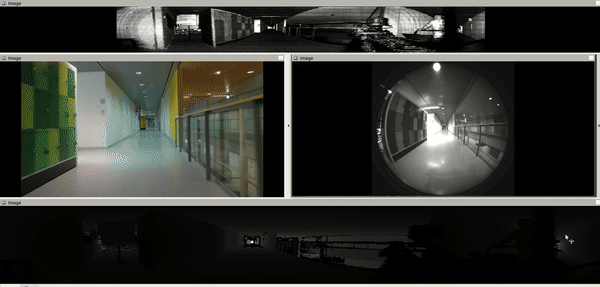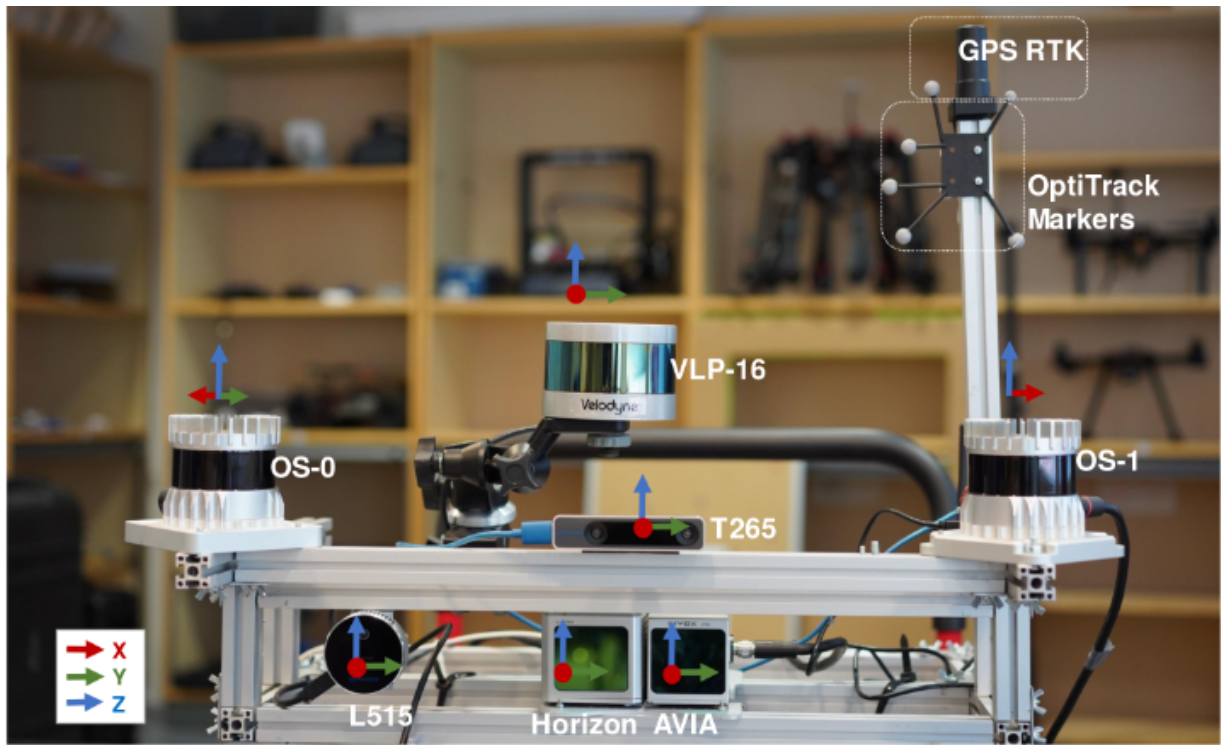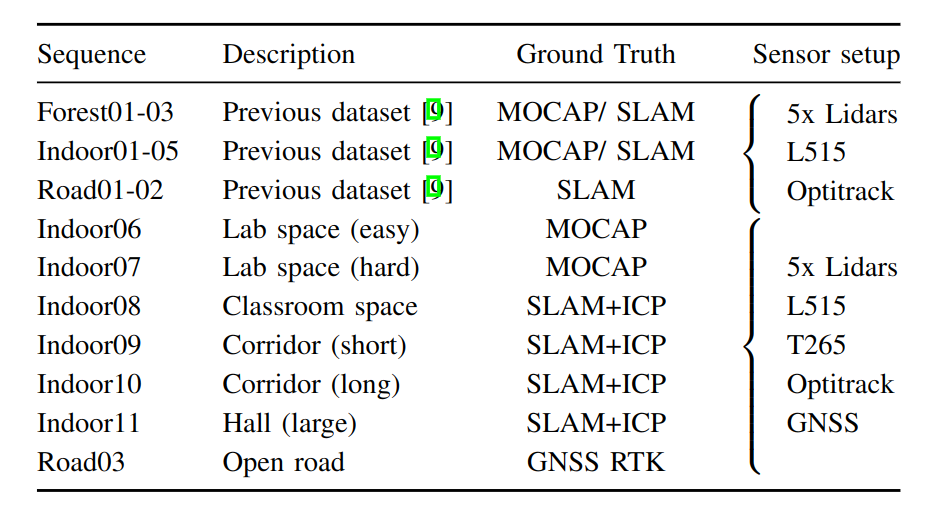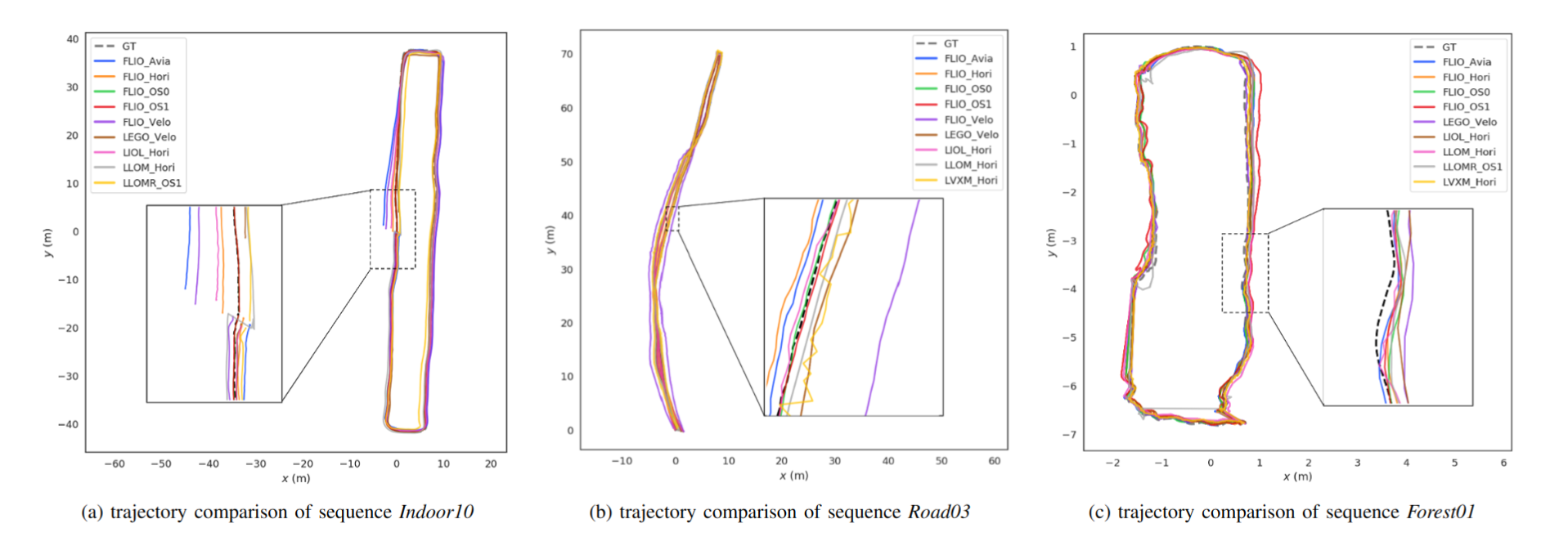Welcome to TIERS Enhanced lidars dataset! You can check our preprint paper here for more detatil.
(Left)Ground truth map for one of the indoor sequences generated based on the proposed approach (SLAM-assisted ICP-based prior map). This enables benchmarking of lidar odometry and mapping algorithms in larger environments where a motion capture system or similar is not available, with significantly higher accuracy than GNSS/RTK solutions.
| OS0 | OS1 | Horizon | Avia | Velo |
|---|---|---|---|---|
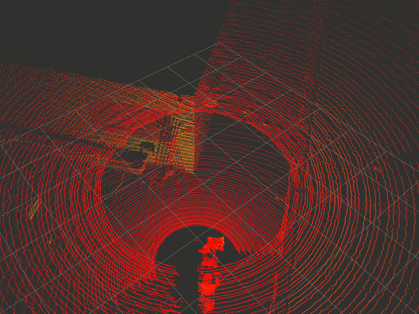 |
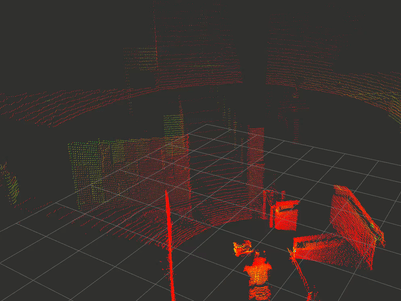 |
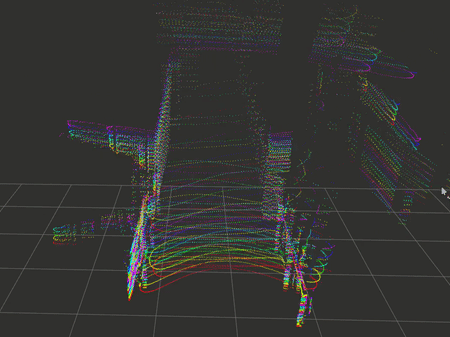 |
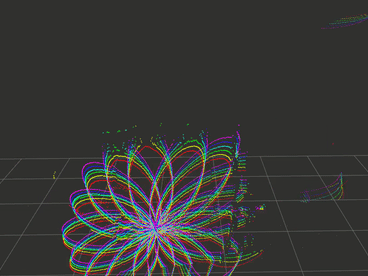 |
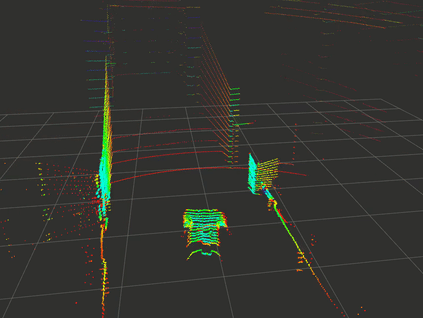 |
Our dataset was captured by a rich suite of sensors. Subsets of the data from the Indoor10 sequence are visualized here. From left to right are the lidar data of Ouster OS0, OusterOS1, Livox Horizon, Livox Avia, and Velodyne Lidar.
The above images show the reflection map (top) and the range map (bottom) of Ouster OS0, respectively. The left one in the middle is the image data of L515, and the one on the right is the fisheye image data of T265.
| Indoor data(Calibrate Sequence) | OpenRoad SLAM example(Road03 Sequence) |
|---|---|
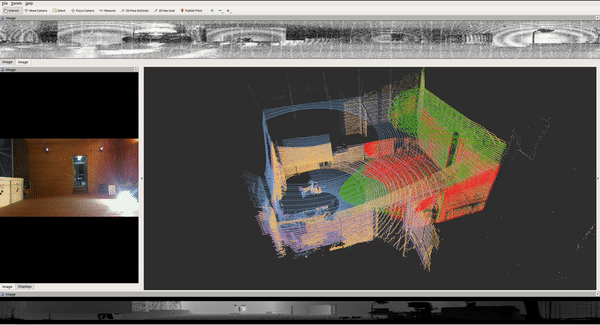 |
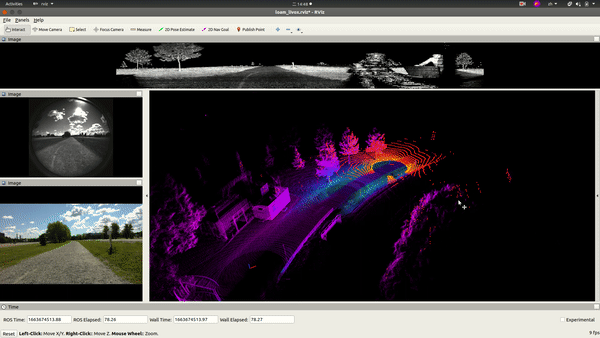 |
| Corridor SLAM example(Indoor10 Sequence) | Forest SLAM example(Forest01 Sequence) |
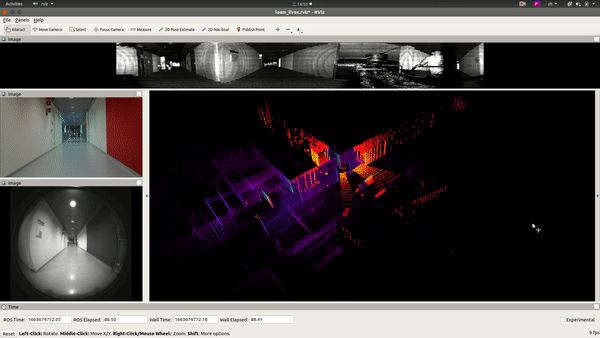 |
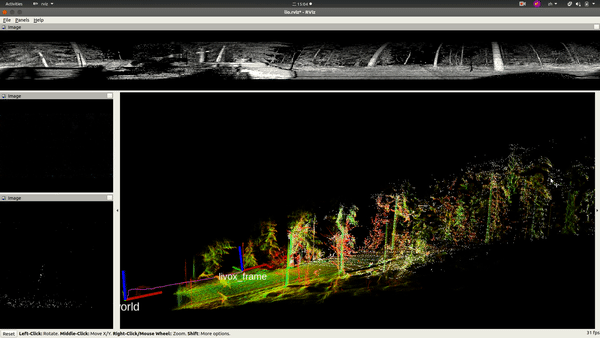 |
The dataset is available at the University of Turku servers. Specific links for each sequence and for the ground truth data are available in Section 3.1 of this file.
Lidar-based simultaneous localization and mapping (SLAM) approaches have obtained considerable success in autonomous robotic systems. This is in part owing to the high-accuracy of robust SLAM algorithms and the emergence of new and lower-cost lidar products. This study benchmarks current state-of-the-art lidar SLAM algorithms with a multi-modal lidar sensor setup showcasing diverse scanning modalities (spinning and solid-state) and sensing technologies, and lidar cameras, mounted on a mobile sensing and computing platform. We extend our previous multi-modal multi-lidar dataset with additional sequences and new sources of ground truth data. Specifically, we propose a new multi-modal multi-lidar SLAM-assisted and ICP-based sensor fusion method for generating ground truth maps. With these maps, we then match real-time pointcloud data using a natural distribution transform (NDT) method to obtain the ground truth with full 6 DOF pose estimation. This novel ground truth data leverages high-resolution spinning and solid-state lidars. We also include new open road sequences with GNSS-RTK data and additional indoor sequences with motion capture (MOCAP) ground truth, complementing the previous forest sequences with MOCAP data. We perform an analysis of the positioning accuracy achieved with ten different SLAM algorithm and lidar combinations. We also report the resource utilization in four different computational platforms and a total of five settings (Intel and Jetson ARM CPUs). Our experimental results show that current state-of-the-art lidar SLAM algorithms perform very differently for different types of sensors.
Keywords: Lidar, Dataset, Multi-modal, Multi-scenario, SLAM, Solid-state lidarsAutonomous driving, LiDAR SLAM benchmark solid-state LiDAR, SLAM
-
a ground truth trajectory generation method for environments where MOCAP or GNSS/RTK are unavailable that leverages the multi-modality of the data acquisition platform and high-resolution sensors;% by solid-state lidar with a Non-repetitive scanning pattern and high-resolution spinning lidar.
-
a new dataset with data from 5 different lidar sensors, one lidar camera, and one stereo fisheye cameras in a variety of environments as illustrated in here . Ground truth data is provided for all sequences;
-
the benchmarking of ten state-of-the-art filter-based and optimization-based SLAM methods on our proposed dataset in terms of the accuracy of odometry, memory and computing resource consumption. The results indicate the limitations of current SLAM algorithms and potential future research directions.
2022.09.20 Initial dataset upload
2022.09.20 Update rosbag links
This work is licensed under the MIT license and is provided for academic purpose. Please contact us at sierha@utu.fi or qingqli@utu.fi for further information.
Physical drawings and schematics of the sensor suite is given below. The unit of the figures is centimeter.
Our data collecting platform, front view RGB (left).
Sensor specification for the presented dataset. Angular resolution is configurable in the OS1-64 (varying the vertical FoV). Livox lidars have a non-repetitive scan pattern that delivers higher angular resolution with longer integration times. Range is based on manufacturerinformation, with values corresponding to 80% Lambertian reflectivity and 100 klx sunlight, except for the L515 and Realsense T265 lidar camera.
The rostopics of our rosbag sequences are listed as follows:
-
VLP-16 LIDAR :
/velodyne_points sensor_msgs/PointCloud2 -
OS0 LIDAR :
/os0_cloud_node/imu : sensor_msgs/Imu
/os0_cloud_node/points : sensor_msgs/PointCloud2/os0_img_node/nearir_image : sensor_msgs/Image
/os0_img_node/range_image : sensor_msgs/Image
/os0_img_node/reflec_image : sensor_msgs/Image -
OS1 LIDAR : \
/os1_cloud_node/imu : sensor_msgs/Imu
/os1_cloud_node/points : sensor_msgs/PointCloud2 -
Horizon LIDAR :
/horizon/livox/imu : sensor_msgs/Imu/horizon/livox/lidar : livox_ros_driver/CustomMsg -
AVIA LIDAR :
/avia/livox/imu : sensor_msgs/Imu
/avia/livox/lidar : livox_ros_driver/CustomMsg -
L515 LIDAR CAMERA:
/l515/accel/sample : sensor_msgs/Imu
/l515/color/image_raw : sensor_msgs/Image
/l515/depth/color/points : sensor_msgs/PointCloud2
/l515/depth/image_rect_raw : sensor_msgs/Image
/l515/gyro/sample : sensor_msgs/Imu -
T265 LIDAR CAMERA:
/t265/accel/sample : sensor_msgs/Imu
/t265/fisheye1/image_raw : sensor_msgs/Image
/t265/fisheye2/image_raw : sensor_msgs/Image
/t265/gyro/sample : sensor_msgs/Imu
/t265/odom/sample : nav_msgs/Odometry
The rostopics of our rosbag sequences are listed as follows:
-
VLP-16 LIDAR :
/velodyne_points sensor_msgs/PointCloud2 -
OS0 LIDAR :
/os0_cloud_node/imu : sensor_msgs/Imu
/os0_cloud_node/points : sensor_msgs/PointCloud2/os0_img_node/nearir_image : sensor_msgs/Image
/os0_img_node/range_image : sensor_msgs/Image
/os0_img_node/reflec_image : sensor_msgs/Image -
OS1 LIDAR : \
/os1_cloud_node/imu : sensor_msgs/Imu
/os1_cloud_node/points : sensor_msgs/PointCloud2 -
Horizon LIDAR :
/horizon/livox/imu : sensor_msgs/Imu/horizon/livox/lidar : livox_ros_driver/CustomMsg -
AVIA LIDAR :
/avia/livox/imu : sensor_msgs/Imu
/avia/livox/lidar : livox_ros_driver/CustomMsg -
L515 LIDAR CAMERA:
/l515/accel/sample : sensor_msgs/Imu
/l515/color/image_raw : sensor_msgs/Image
/l515/depth/color/points : sensor_msgs/PointCloud2
/l515/depth/image_rect_raw : sensor_msgs/Image
/l515/gyro/sample : sensor_msgs/Imu -
T265 LIDAR CAMERA:
/t265/accel/sample : sensor_msgs/Imu
/t265/fisheye1/image_raw : sensor_msgs/Image
/t265/fisheye2/image_raw : sensor_msgs/Image
/t265/gyro/sample : sensor_msgs/Imu
/t265/odom/sample : nav_msgs/Odometry -
MOCAP SYSTEM:
/vrpn_client_node/optitest/pose : geometry_msgs/PoseStamped -
GNSS/RTK: \
/mavros/global_position/global : sensor_msgs/NavSatFix/mavros/global_position/local : nav_msgs/Odometry/mavros/global_position/raw/fix : sensor_msgs/NavSatFix/mavros/global_position/raw/gps_vel : geometry_msgs/TwistStamped/mavros/global_position/raw/satellites : std_msgs/UInt32/mavros/imu/data : sensor_msgs/Imu/mavros/imu/mag : sensor_msgs/MagneticField/mavros/local_position/odom : nav_msgs/Odometry
| Sequence Name | Collection Date | Total Size | Duration | Features | Rosbag | GroundTruth |
|---|---|---|---|---|---|---|
| Indoor06 | 2022-08-10 | 19.7g | 64s | day,indoor,office | Rosbag | SLAM+ICP link |
| Indoor07 | 2022-07-16 | 22.4g | 73s | day,indoor,office | Rosbag | SLAM+ICP link |
| Indoor08 | 2022-07-05 | 33.1g | 89s | day,indoor,office | Rosbag | SLAM+ICP link |
| Indoor09 | 2022-07-11 | 48.7g | 168s | day,indoor,corridor | Rosbag | SLAM+ICP link |
| Indoor10 | 2022-06-07 | 43.0g | 121s | day,indoor,corridor | Rosbag | SLAM+ICP link |
| Indoor11 | 2021-06-06 | 79.5g | 237s | day,indoor,hall | Rosbag | SLAM+ICP link |
| Road3 | 2022-06-17 | 44.0g | 146s | summer,outdoor,road | Rosbag | GNSS/RTK link |
| Forest01 | 2022-02-08 | 21.9g | 62s | Winter,night,Square | Rosbag | MOCAP link |
| Forest02 | 2022-02-08 | 22.4g | 73s | Winter,night,Straight | Rosbag | MOCAP link |
- There are also previous datasets, please check here
The meaning of each column in ground truth files is as follows:
timestamp, pose.position.x, pose.position.y, pose.position.z, pose.orientation.x, pose.orientation.y, pose.orientation.z, pose.orientation.w.
In the MOCAP system available environment, the ground truth data from the MOCAP system are recorded in rosbag. The user can generate the ground truth file by himself. A Script named 'result_sub_ros.py' is provided in the scripts folder to record the result and save it into a CSV file.
python2 result_sub_ros.py
| Sequence Name | Collection Date | Total Size | Duration | Features | Rosbag |
|---|---|---|---|---|---|
| LidarsCali | 2022-02-11 | 21.9g | 19.1s | room | Rosbag |
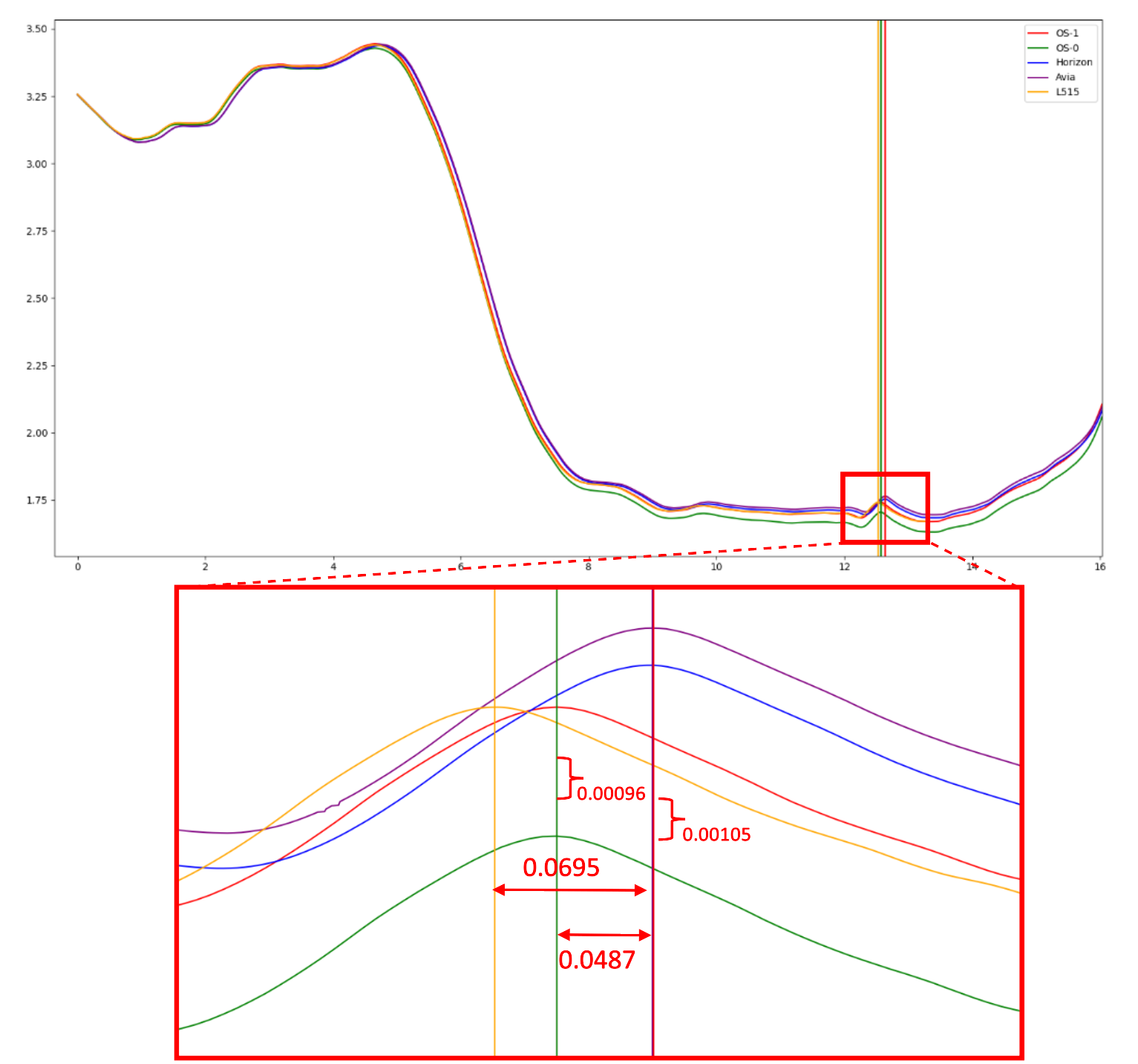
The graph shows the change in the yaw value of the IMU of each lidar in the dataset. It can be seen from the picture that the average time offset of the dataset does not exceed 5ms.
We teseted some well-known lidar SLAM methods, which are listed below:
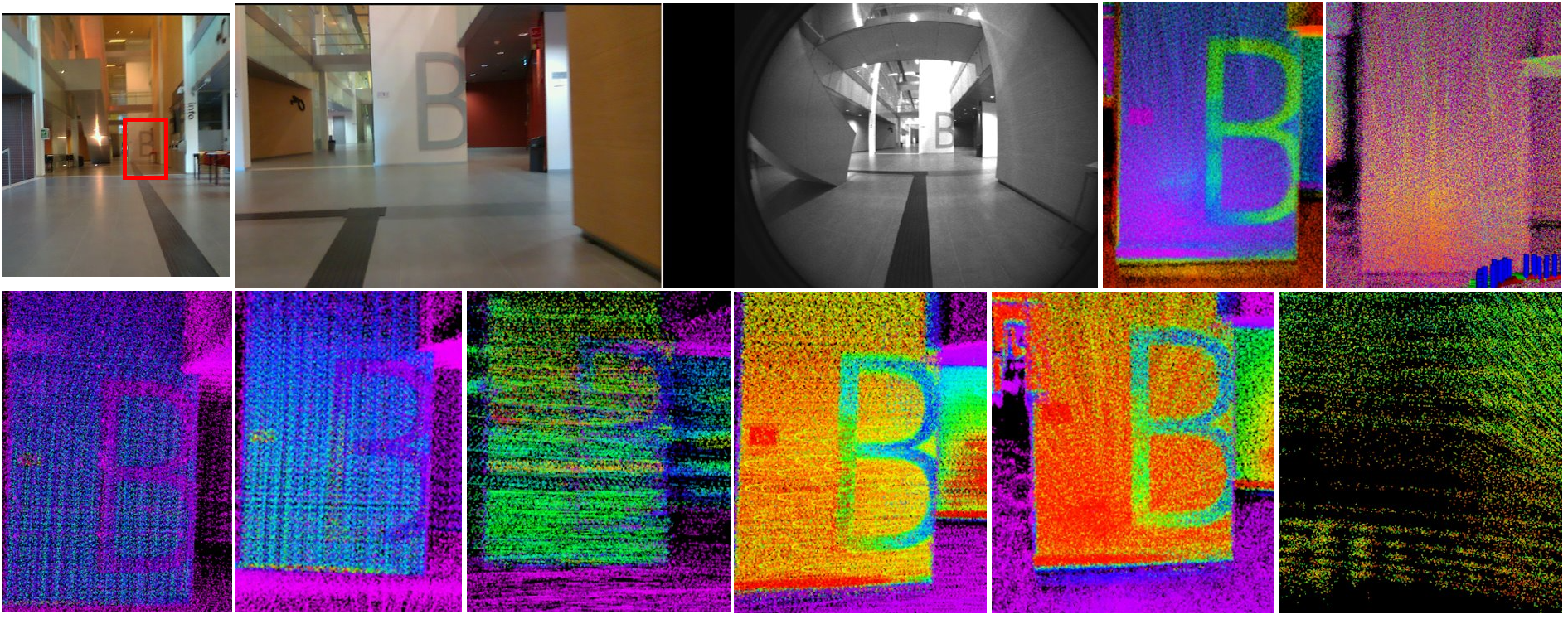
Qualitative comparison of the mapping quality. Top row showm the rgb image, fisheye image ,map LIOL Horizon, Livox_Mapping Horizon. Bottom row shows mapping result from OS0-based FLIO, OS1-based FLIO, Velodye-based FLIO, Avis-based FLIO, and Horizon-based FLIO, and Velodyne's LeGo-LOAM maps, respectively.
Rosbag recoreds message with their raw frame_id. If user need to show or run multiple lidar same time, we use srv_tools to change frame_id of each topics. To install srv_tools, please follow srv_tools installation.
Then follow the commands below:
cd ./scripts/ # Go to scripts folder
python2 change_frameid.py [inbag_path] [outbag_path] # Specify bag path
Note: This script will transform the raw frame_id to new one(right) as based on topic(left) follows:
"/avia/livox/lidar" -> "avia_frame"
"/avia/livox/imu" -> "avia_frame"
"/livox/imu" -> "horizon_frame"
"/livox/lidar" -> "horizon_frame"
"/os_cloud_node/points" -> "os0_sensor"
"/os_cloud_node/imu" -> "os0_imu"
"/os_cloud_nodee/points" -> "os1_sensor"
"/os_cloud_nodee/imu" -> "os1_imu"
Ubuntu 64-bit 16.04 or 18.04. ROS Kinetic or Melodic. ROS Installation and its additional ROS pacakge:
sudo apt-get install ros-${ROS_DISTRO}-cv-bridge ros-${ROS_DISTRO}-tf ros-${ROS_DISTRO}-message-filters ros-${ROS_DISTRO}-image-transport
NOTE You need to source your ROS installation for the $ROS_DISTRO env variable to be defined. For example, if your use ROS-melodic, the command should be:
sudo apt-get install ros-melodic-cv-bridge ros-melodic-tf ros-melodic-message-filters ros-melodic-image-transport
Follow PCL Installation.
To visualize data, we need install the Livox LiDAR SDK. Follow instructions Livox-ros-driver installation
cd ~/catkin_ws/src
git clone git@github.com:TIERS/multi-lidar-dataset.git
cd ..
catkin_make -DCATKIN_WHITELIST_PACKAGES="dataset_tools"
source /devel/setup.bash
Finally, we can visulize all data by
roslaunch dataset_tools data_show.launch
We use open-source tool evo for evalutation.
To evaluate LIDAR SLAM, you can run:
evo_ape tum optk.txt {SLAM_result}.txt -a -p
We provide a tool for extrinsic parameters between lidars that can calculate the extrinsic parameter based on GICP methods. As the OS0 has the highest FOV, we first rotate the coordinate of OS0 sensor 45 degrees to align its X-axis with Horizon, Avia and Velodyne. Then the rotated coordinate is treated as "base_link". All clouds from other lidar are matched with the "base_link" coordinate. For Avia, Horizon, we integrated the first five frames to increase point cloud density and reduce its low FOV impact.
To use this tools, first play one rosbag from our dataset:
rosbag play ICT_OUT_2022-02-20-17-34-49.bag --clock
Then run our calibration launch file:
roslaunch dataset_tools lidars_extri_comp.launch
Then you can find the calculated parameter, and its transformed cloud;
OS0 -> base_link 0 0 0 0.785398 -0 0 /os0_sensor /base_link 10
OS1 -> base_link 0.0100882 0.581502 -0.0210581 2.34826 3.12619 -3.13066 /os1_sensor /base_link 10
velo -> base_link -0.164831 0.173188 0.117624 3.07795 3.09161 3.12807 /velo_sensor /base_link 10
Avia -> base_link -0.0608374 0.29663 -0.122276 0.00549421 0.000246092 -0.011555 /avia_frame /base_link 10
hori -> base_link 0.00345477 0.145195 -0.134907 3.12905 3.14022 3.12706 /hori_frame /base_link 10
The RVIZ window will be opened and show the aligned point cloud.
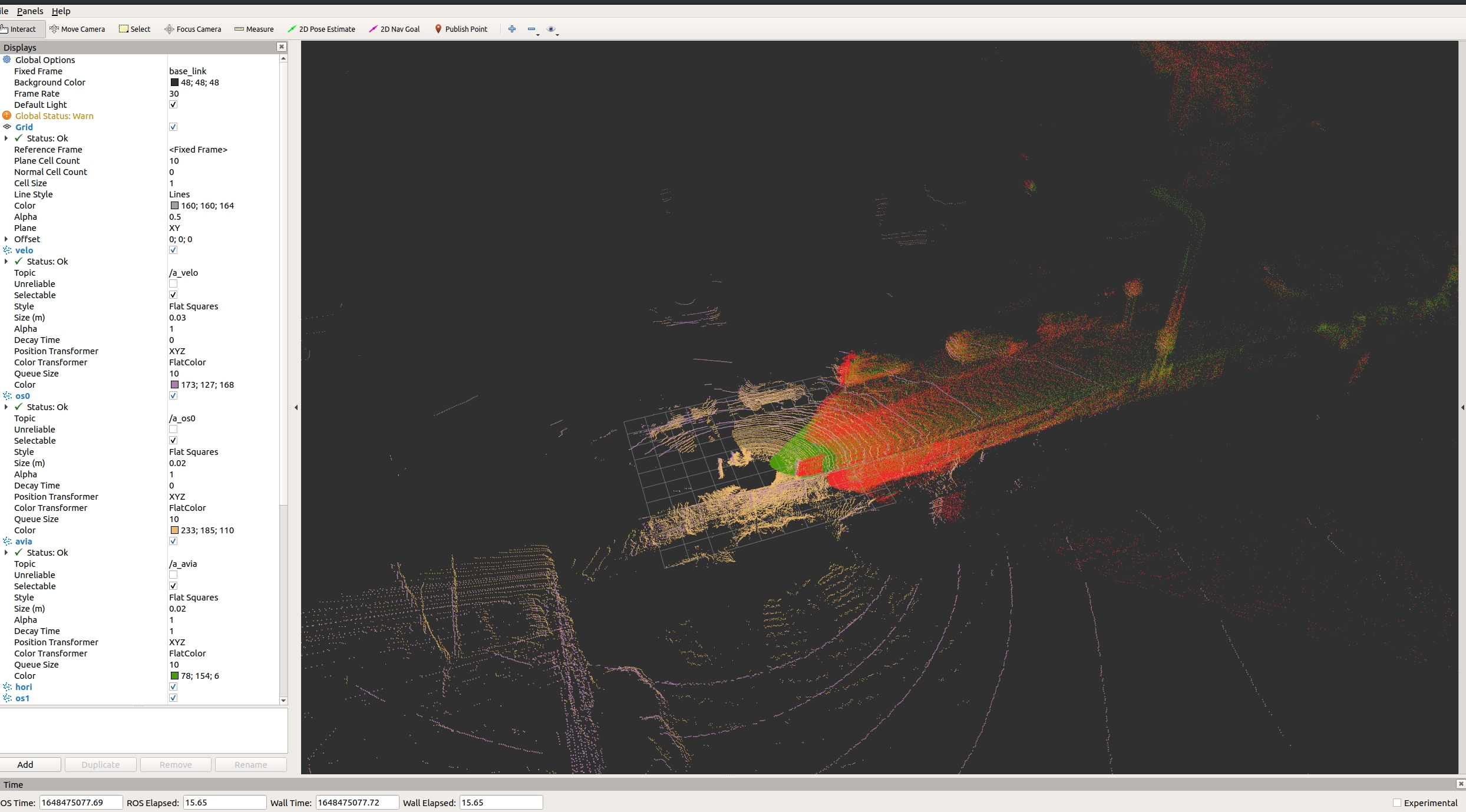
For IMU intrinsics, visit Imu_utils
For extrinsics between cameras and LIVOX Lidar, visit livox_camera_lidar_calibration
Avia: https://www.livoxtech.com/avia,
Horizon:https://www.livoxtech.com/horizon,
OS0:https://ouster.com/products/scanning-lidar/os0-sensor/,
OS1:https://ouster.com/products/scanning-lidar/os1-sensor/,
Vlp-16:https://velodynelidar.com/products/puck/,
Realsense L515:https://www.intelrealsense.com/lidar-camera-l515/.
This research work is supported by the Academy of Finland's AeroPolis project (Grant 348480) and the Finnish Foundation for Technology Promotion (Grants 7817 and 8089).
Please cite our Dataset paper if the code or data in this repo helps your work:
@article{li2022dataset,
title={Multi-Modal Lidar Dataset for Benchmarking General-Purpose Localization and Mapping Algorithms},
author={ Li, Qingqing and Yu, Xianjia and Pe{\~n}a Queralta, Jorge and Westerlund, Tomi},
journal={arXiv preprint arXiv:2203.03454},
year={2022}
}

